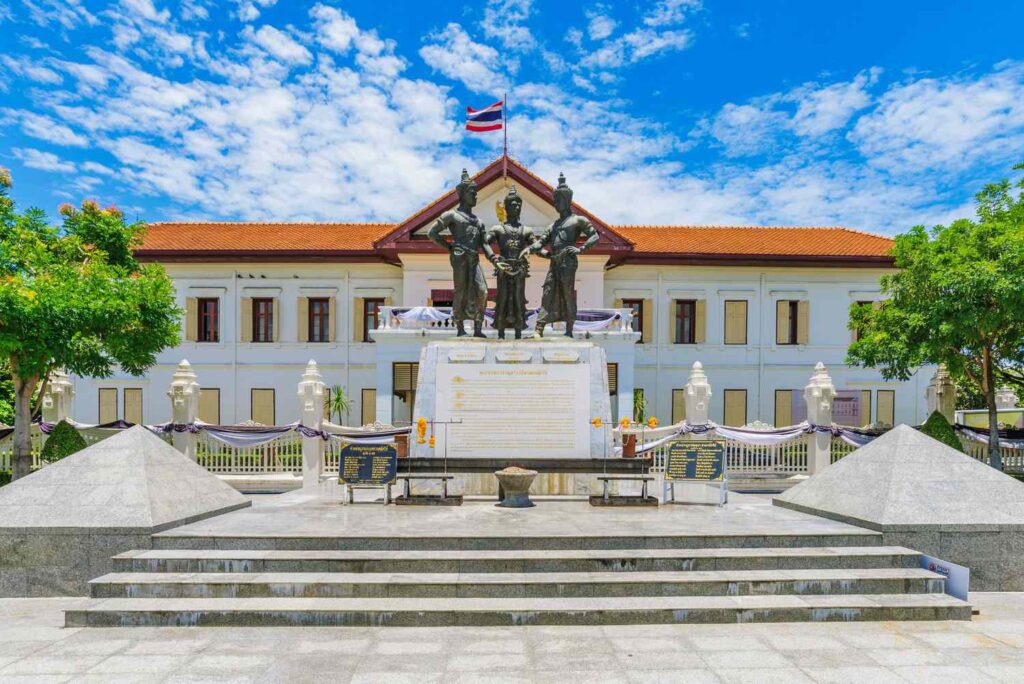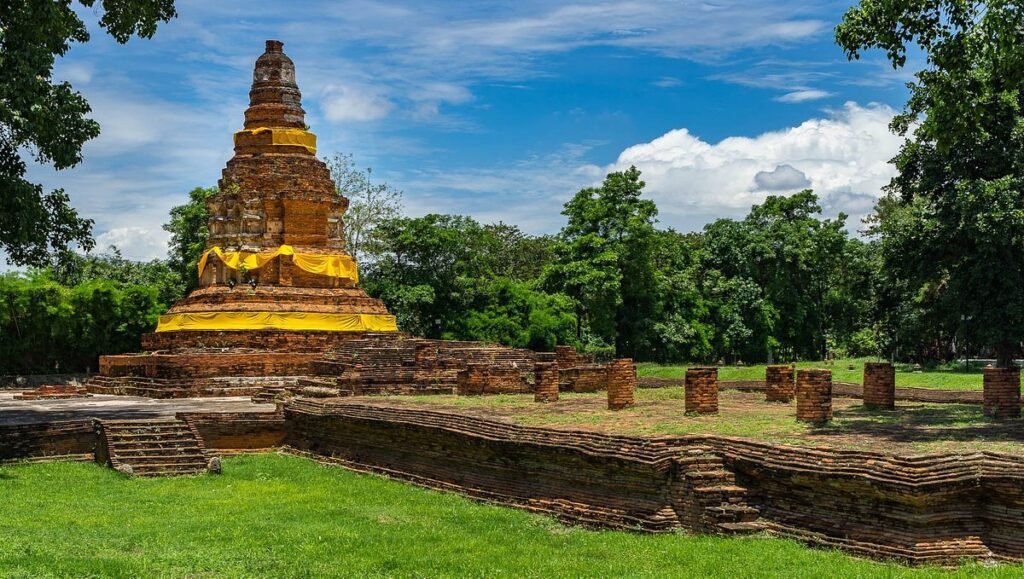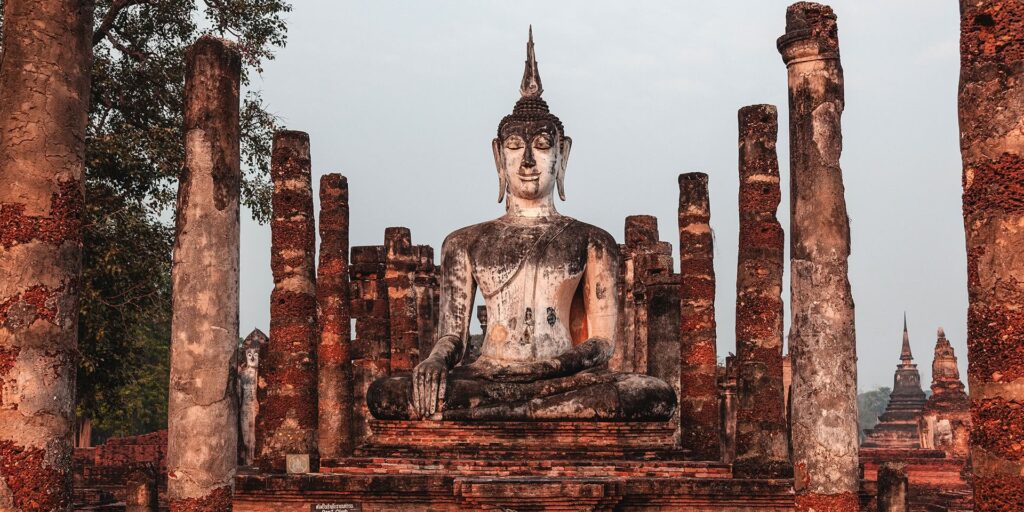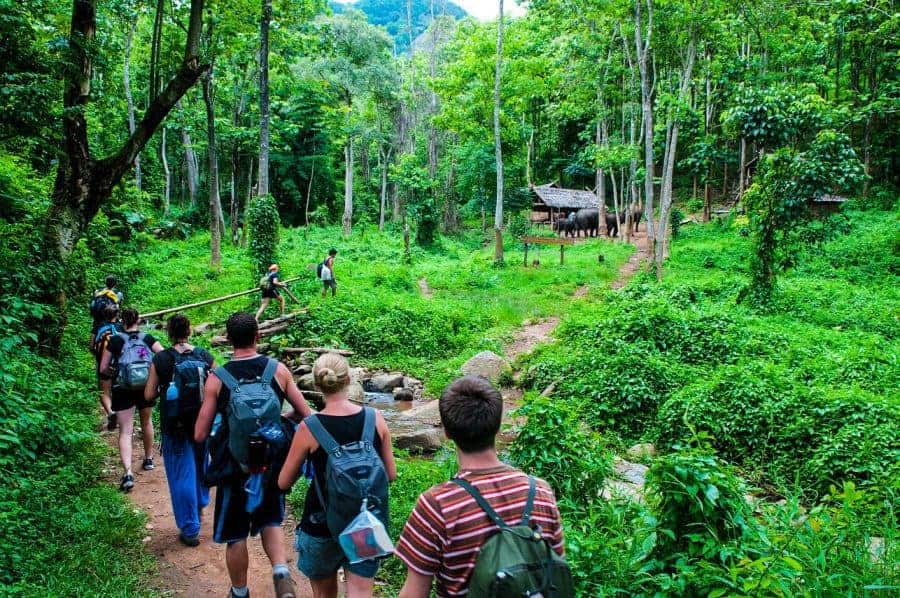The Old City – A Walk Through Time
Step into a bygone era as we journey through Chiang Mai’s Old City, a place where history comes alive with every step. Enclosed by ancient city walls and guarded by majestic gates, this part of Chiang Mai is a living testament to the city’s rich heritage.
The Enigmatic Walls and Gates
As you enter the Old City, you’ll be greeted by towering remnants of history – the ancient city walls and gates. These fortifications once served as the protective barrier for Chiang Mai during its early days as the capital of the Lanna Kingdom.
The walls stretch for approximately 1.5 kilometers in each direction, forming a perfect square that encapsulates the heart of the Old City. Four main gates punctuate the walls: Tha Phae Gate to the east, Chiang Mai Gate to the south, Suan Dok Gate to the west, and Chang Puak Gate to the north. Each gate has its unique architectural charm and historical significance.
Historical Sites Within
Once inside the Old City, you’ll find yourself amidst a treasure trove of historical sites. Among these, Wat Chedi Luang stands as a testament to the architectural prowess of the Lanna Kingdom. This grand temple was once home to the Emerald Buddha, Thailand’s most revered religious artifact, before it was relocated to Bangkok.
The Three Kings Monument, located in the heart of the Old City, pays homage to the three kings who played pivotal roles in Chiang Mai’s history. This bronze monument is a popular gathering spot and a reminder of the city’s royal legacy.
The City Moat – A Watery Legacy
One cannot explore the Old City without noticing the serene moat that encircles its ancient streets. The city moat, known as “Phae Khanong” in Thai, once served both as a protective barrier and a source of water for the city’s inhabitants. Today, it adds to the charm of the Old City and provides a tranquil backdrop to your historical journey.
The Old City’s streets are a blend of history, culture, and modern life. As you wander through its narrow lanes, you’ll discover traditional teakwood houses, bustling markets, and ornate temples. The centuries-old traditions coexist harmoniously with contemporary Chiang Mai, creating a unique atmosphere that’s both enchanting and captivating.
Join us as we embark on a walk through time, exploring the ancient walls, discovering historical treasures, and uncovering the significance of the city moat. In the chapters that follow, we’ll delve deeper into the stories and legends that have shaped the Old City into the cultural gem it is today.


Majestic Temples with Historical Significance
Chiang Mai is often referred to as the “Rose of the North,” and at the heart of this blooming city are its majestic temples, each with a rich history and unique architectural charm. In this chapter, we will embark on a journey to explore some of the most renowned temples in Chiang Mai, delving into their historical significance and intricate details.
Wat Phra Singh: The Crown Jewel
Our first stop is at Wat Phra Singh, a temple that stands as a testament to the city’s spiritual and artistic heritage. This dazzling temple complex is home to the revered Phra Singh Buddha, a statue that dates back to the 14th century. Wat Phra Singh’s intricate Lanna-style architecture, glistening gold accents, and beautifully manicured grounds make it a must-visit destination for history enthusiasts and spiritual seekers alike.
Wat Chiang Man: Chiang Mai’s Oldest Temple
Our journey continues to Wat Chiang Man, Chiang Mai’s oldest temple, which predates the founding of the city itself. This temple holds immense historical significance as it was built by King Mengrai, the founder of Chiang Mai, in 1296. Wat Chiang Man houses two highly venerated Buddha images, the Crystal Buddha and the Marble Buddha. The temple’s serene ambiance and ancient relics transport visitors back in time to Chiang Mai’s inception.
Discovering Lesser-Known Gems
While Wat Phra Singh and Wat Chiang Man take center stage in Chiang Mai’s temple scene, there are many lesser-known yet historically important temples waiting to be explored. Wat Buppharam, known for its exquisite murals depicting the life of the Buddha, offers a glimpse into the artistic achievements of the Lanna Kingdom. Wat Umong, nestled in a tranquil forest setting, provides a serene escape from the city’s hustle and bustle.
Architectural Marvels and Spiritual Sanctuaries
As we delve into the architectural marvels and spiritual sanctuaries of Chiang Mai’s temples, we will uncover the stories, legends, and cultural significance that have shaped these sacred sites. From the intricate woodwork of Wat Phra Singh to the ancient relics of Wat Chiang Man, each temple holds a unique tale of devotion, artistry, and history.
Join us on this enlightening journey as we explore the majesty and historical significance of Chiang Mai’s temples, both famous and hidden, and gain a deeper appreciation for the city’s cultural treasures.


Museums Showcasing Lanna Heritage
Chiang Mai, a city steeped in history and culture, is home to a treasure trove of museums that offer a fascinating glimpse into the rich heritage of the Lanna Kingdom and Northern Thailand. In this chapter, we will embark on a journey through some of the most prominent museums in Chiang Mai, each of which contributes to the tapestry of Lanna heritage.
Chiang Mai National Museum: Gateway to the Past
Our first stop is the Chiang Mai National Museum, a veritable gateway to the past. This museum is a comprehensive repository of artifacts, art, and historical exhibits that span centuries. Visitors can explore the evolution of the Lanna Kingdom, from its early origins to its zenith, through a remarkable collection of sculptures, ceramics, textiles, and more. The museum provides a deep understanding of the region’s cultural heritage and its historical significance in the context of Thailand.
Lanna Folklife Museum: A Cultural Chronicle
The Lanna Folklife Museum is an immersive experience that takes visitors on a journey through the daily lives, traditions, and folklore of the Lanna people. Housed in a beautifully preserved colonial-style building, this museum showcases traditional clothing, tools, and artifacts, shedding light on the customs and practices of Northern Thailand’s indigenous communities. The Lanna Folklife Museum is a living testament to the region’s cultural diversity and the resilience of its heritage.
Specialty Museums: Hidden Treasures
Chiang Mai boasts a variety of specialty museums that cater to niche interests and offer unique perspectives on Lanna heritage. The Tribal Museum, for example, provides insights into the diverse ethnic groups that call Northern Thailand home, with exhibits on their customs, clothing, and traditions. Meanwhile, the Warorot Market Museum immerses visitors in the history of the bustling Warorot Market, a vital hub of commerce and culture in Chiang Mai.
Exploring the Past, Enriching the Present
As we explore these museums, we will unravel the stories, artistry, and craftsmanship that have shaped the Lanna culture. From intricate textiles and ancient artifacts to oral histories and contemporary art, each museum offers a different facet of Northern Thailand’s rich heritage. Together, they form a collective narrative that enriches our understanding of Chiang Mai and its place in the annals of history.
Join us on this enlightening journey as we delve into the museums showcasing Lanna heritage, and discover the vibrant tapestry of traditions, artistry, and history that define this captivating region.


The Ancient City of Wiang Kum Kam
Nestled just a few kilometers south of Chiang Mai’s bustling city center lies a hidden gem of historical significance – Wiang Kum Kam. In this chapter, we will embark on a journey through time to discover the intriguing history, the captivating rediscovery, and the best ways to experience this ancient archaeological site.
Rediscovering Wiang Kum Kam: Unearthing History
Wiang Kum Kam, also known as “Wiang Kum Kam the Underground Ancient City,” has a history that dates back over 700 years. Founded by King Mengrai, the legendary founder of Chiang Mai, this ancient city served as the capital of the Lanna Kingdom for a brief period during the 13th century. However, frequent flooding from the nearby Ping River led to its abandonment, burying it beneath layers of earth and obscurity.
It wasn’t until the late 20th century that Wiang Kum Kam was rediscovered by archaeologists. Their excavations unveiled a wealth of historical treasures, including centuries-old temples, sculptures, pottery, and architectural remnants. This reawakening of Wiang Kum Kam has allowed visitors to step back in time and explore the hidden secrets of this once-lost city.
Exploring the Archaeological Site: A Glimpse into the Past
Visiting Wiang Kum Kam is like entering a portal to the past. The site is adorned with ancient temples, some of which showcase exquisite Lanna-style architecture and intricate stucco decorations. Wat Chedi Liam, with its imposing square-shaped stupa, is a prominent highlight. Wat E-Kang, known for its impressive Buddha statues, is another must-see.
As you wander through the site, you’ll come across ancient relics and inscriptions that offer insights into the lives of the people who once inhabited this city. The well-preserved artifacts provide a window into the history, art, and culture of the Lanna Kingdom.
Tips for an Enriching Experience
To make the most of your visit to Wiang Kum Kam, consider these tips:
Local Guides: Engage the services of a knowledgeable local guide who can share the historical significance and stories associated with each temple and structure.
Transportation: While Wiang Kum Kam is accessible by car or scooter, many visitors choose to explore the site by horse-drawn carriage for a unique and leisurely experience.
Time Your Visit: The archaeological site is open year-round, but it’s advisable to visit during the cooler months between November and February to avoid the sweltering heat.
Combine with Nearby Attractions: Wiang Kum Kam is conveniently located near other attractions, such as the San Kamphaeng Hot Springs and the Ban Tawai Handicraft Village, making it easy to plan a day of exploration.
Respect and Preservation: As you explore, remember that Wiang Kum Kam is an archaeological site, and it’s important to treat it with respect. Please do not touch or climb on the ancient structures, and adhere to any preservation guidelines provided.
Rediscovering Wiang Kum Kam
Wiang Kum Kam offers a unique opportunity to step back in time and witness the historical grandeur of the Lanna Kingdom. As you explore the ancient temples, sculptures, and relics, you’ll gain a deeper appreciation for the rich heritage of Northern Thailand. Join us on this captivating journey as we rediscover the hidden treasures of Wiang Kum Kam.


Historical Villages and Ethnic Communities
As we continue our exploration of Northern Thailand’s cultural tapestry, we venture beyond the city limits of Chiang Mai to discover the rich heritage of historical villages and the vibrant cultures of hill tribes. Join us on this journey of cultural immersion and appreciation.
Baan Hong Nual: A Glimpse into the Past
Our first stop is the historical village of Baan Hong Nual, located a short drive from Chiang Mai. This quaint village offers a fascinating glimpse into the region’s history, with its well-preserved teakwood houses that showcase traditional Lanna architecture. As you wander through the village, you’ll be transported back in time, surrounded by the rustic charm of centuries-old homes.
One of the village’s main attractions is the Baan Hong Nual Museum, where you can delve deeper into the history and culture of the Lanna Kingdom. The museum houses a collection of artifacts, antique tools, and historical photographs that provide insights into the daily lives of the villagers in days gone by.
Baan Tawai: The Village of Artisans
Our next destination takes us to Baan Tawai, often referred to as the “Village of Artisans.” This artistic enclave is renowned for its exquisite woodcarvings, handcrafted furniture, and traditional handicrafts. Baan Tawai is a hub for local artisans who have mastered the art of creating intricate woodwork, sculptures, and decorative items.
As you explore Baan Tawai’s artisan workshops and galleries, you’ll have the opportunity to witness skilled craftsmen at work. From elaborately carved Buddha statues to intricately designed furniture, the craftsmanship on display is nothing short of impressive. Visitors can also shop for unique souvenirs and one-of-a-kind pieces to take home.
Hill Tribes of Northern Thailand: A Cultural Odyssey
Our journey through Northern Thailand wouldn’t be complete without experiencing the rich and diverse cultures of the region’s hill tribes. Northern Thailand is home to several ethnic communities, each with its own unique traditions, languages, and customs. Visiting these hill tribes offers a chance to engage in cultural exchanges and gain a deeper understanding of their way of life.
Some of the hill tribes you may encounter include the Karen, Akha, Hmong, and Lisu, among others. Many of these tribes reside in the picturesque mountains and hills surrounding Chiang Mai. You can choose to visit their villages and interact with the locals, learn about their traditional clothing, crafts, and agricultural practices, and even participate in cultural activities and ceremonies.
Supporting Local Communities
When visiting historical villages and hill tribe communities, it’s essential to do so responsibly and respectfully. Here are some tips for a meaningful and responsible cultural experience:
Respect Local Customs: Be mindful of cultural norms and traditions. Dress modestly and ask for permission before taking photographs.
Support Local Artisans: When shopping for souvenirs or crafts, consider purchasing directly from local artisans or cooperatives to support their livelihoods.
Responsible Tourism: Choose tour operators or guides who promote responsible tourism and prioritize the well-being of the communities you visit.
Cultural Exchange: Engage with the locals, ask questions, and embrace the opportunity for cross-cultural learning and dialogue.
Leave No Trace: Dispose of trash responsibly and leave the environment as you found it. Avoid leaving behind any negative impact on the communities you visit.
A Cultural Odyssey Beyond Chiang Mai
Our journey to historical villages and hill tribe communities provides a window into the rich tapestry of Northern Thailand’s cultural heritage. By exploring these unique destinations and engaging with local communities, you’ll not only create unforgettable memories but also contribute to the preservation of these traditions for generations to come. Join us as we embark on a cultural odyssey that celebrates diversity and promotes responsible tourism.


Guided Historical Tours and Experiences
As we continue our journey through the historical and cultural wonders of Northern Thailand, we delve into the world of guided historical tours and immersive experiences that offer deeper insights into the region’s rich heritage. Join us as we explore the past through the lens of expert guides and hands-on workshops.
Guided Historical Tours: Unveiling the Past
One of the best ways to uncover the hidden stories and historical treasures of Chiang Mai is by joining a guided historical tour. These tours are led by knowledgeable guides who are passionate about sharing the city’s history and cultural heritage.
Old City Walking Tours
Embark on a walking tour through Chiang Mai’s Old City, where history comes to life with every step. Guided by experienced historians and local experts, you’ll explore ancient temples, city walls, and historical landmarks. Some of the must-visit sites include:
Wat Phra Singh: Discover the intricate architecture and centuries-old relics of this revered temple.
Tha Pae Gate: Learn about the significance of the city gate and its role in Chiang Mai’s history.
Three Kings Monument: Uncover the stories behind the statues of Chiang Mai’s founding kings.
Cultural Heritage Tours
Immerse yourself in the diverse cultures of Northern Thailand with cultural heritage tours. These experiences take you to the heart of local communities, where you can witness traditional rituals, participate in cultural activities, and engage with indigenous tribes. Highlights include:
Karen Hill Tribe Homestay: Experience the daily life of the Karen tribe, known for their unique long-necked tradition.
Akha Village Visit: Explore Akha hill tribe villages, where you can try traditional Akha clothing and cuisine.
Hmong Cultural Exchange: Engage in Hmong cultural activities, such as embroidery and storytelling.
Traditional Lanna Workshops: Hands-On Learning
To truly appreciate the history and culture of Northern Thailand, consider participating in traditional Lanna workshops. These hands-on experiences allow you to learn age-old crafts and art forms directly from skilled artisans. Here are a few workshops you can enjoy:
Thai Cooking Classes
Discover the secrets of Thai cuisine with cooking classes that focus on traditional Lanna recipes. Join expert chefs as they guide you through the preparation of flavorful dishes using fresh local ingredients. From green curry to mango sticky rice, you’ll master the art of Lanna cooking.
Muay Thai Training
Experience the martial art of Muay Thai with expert trainers. Learn the history, techniques, and rituals of this ancient combat sport while getting a great workout. Whether you’re a beginner or an experienced fighter, there’s a class for everyone.
Traditional Thai Massage
Delve into the world of relaxation and wellness with traditional Thai massage workshops. Skilled therapists will teach you the ancient techniques of Thai massage, allowing you to experience the therapeutic benefits firsthand.
Creating Your Personalized Historical Tour
If you prefer a more customized historical tour, consider creating your itinerary based on your interests and preferences. Here are some tips to help you plan your personalized historical adventure:
Identify Your Interests: Determine which aspects of history and culture intrigue you the most, whether it’s ancient temples, local traditions, or art forms.
Research Local Guides: Seek out knowledgeable local guides or experts who can provide insights into your chosen areas of interest.
Mix and Match: Combine guided tours with immersive workshops to create a well-rounded experience.
Ask for Recommendations: Consult fellow travelers, locals, or tour operators for recommendations on hidden gems and unique experiences.
Plan Ahead: Ensure you book your guided tours and workshops in advance, especially during peak tourist seasons.
An Enriching Journey Through History and Culture
Whether you choose to explore the historical landmarks of Chiang Mai with a knowledgeable guide or immerse yourself in traditional Lanna workshops, your journey through Northern Thailand’s history and culture promises to be enriching and unforgettable. Embrace the opportunity to learn, create, and connect with the past, and let the stories of this remarkable region unfold before your eyes.


Preserving Chiang Mai’s Heritage
Chiang Mai’s rich history and cultural heritage are treasures that must be protected and preserved for future generations. In this final chapter, we delve into the critical topic of heritage conservation and the role of responsible tourism in ensuring that Chiang Mai’s history remains intact.
Conservation Efforts: Protecting the Past
Preserving historical sites, monuments, and traditions is a collective responsibility. Chiang Mai has made significant strides in conserving its heritage through various initiatives:
Restoration Projects
Many historical sites in Chiang Mai undergo meticulous restoration to ensure they remain in their original glory. Preservation experts work tirelessly to repair and maintain ancient temples, walls, and artifacts. Tourists can contribute by respecting restoration sites and following any posted guidelines.
Cultural Festivals
Chiang Mai’s vibrant cultural festivals play a crucial role in heritage preservation. Events like Loy Krathong and Songkran showcase traditional practices and keep cultural traditions alive. By participating in these festivals with respect and understanding, visitors support cultural continuity.
Local Artisans and Craftsmen
The city’s artisans and craftsmen play a vital role in preserving traditional arts and crafts. By supporting local artisans, travelers contribute to the sustainability of these traditional practices. Purchasing handmade crafts not only provides income to artisans but also encourages the passing down of skills to future generations.
Responsible Tourism: Your Role in Preservation
As a visitor to Chiang Mai, you have a unique opportunity to contribute positively to the preservation of its heritage. Here are some ways you can do so:
Respect Cultural Norms
Learn about and respect the local customs and traditions. When visiting temples, dress modestly and remove your shoes before entering. During cultural events and festivals, follow guidelines and show appreciation for the rituals.
Support Sustainable Practices
Choose accommodations, restaurants, and tour operators that prioritize sustainability and responsible tourism. Support businesses that implement eco-friendly practices and contribute to the local community.
Educate Yourself
Take the time to educate yourself about Chiang Mai’s history and culture before and during your visit. Local museums, cultural centers, and guided tours can provide valuable insights. Engaging with local guides and residents can also deepen your understanding.
Contribute to Conservation Efforts
Consider making a donation to heritage conservation organizations or participating in volunteer programs focused on preserving Chiang Mai’s history. Your contributions can directly support restoration projects and cultural initiatives.
The Significance of History
Understanding Chiang Mai’s history is not merely a journey into the past; it’s a gateway to comprehending its present and future. History shapes the city’s identity and informs its cultural practices. By valuing and preserving this heritage, Chiang Mai continues to thrive as a unique and culturally rich destination.
As you explore the ancient temples, stroll along the historic streets, and immerse yourself in local traditions, remember that your actions as a responsible traveler can play a pivotal role in safeguarding Chiang Mai’s heritage for generations to come.
In conclusion, Chiang Mai’s history is a tapestry woven with stories of empires, traditions, and resilience. It is our collective duty to ensure that this tapestry remains intact, vibrant, and accessible to all who seek to unravel its mysteries. As you bid farewell to Chiang Mai, take with you not just memories of its past, but a commitment to preserving its heritage for the future.








